Class 10 MAHARASHTRA STATE TEXTBOOK BUREAU Solutions Maths Chapter 1 - Similarity
Similarity Exercise Ex. 1.1
Solution 1
Given:
The base of triangle, b1 = 9
Height of triangle, h1 = 5
The base of another triangle, b2 = 10
Height of another triangle, h2 = 6
To find:
Ratio of area of these triangles
Area of triangle![]()
Therefore,

The ratio of area of these triangles is 3:4.
Solution 2

Given:
BC ⊥ AB,
AD ⊥ AB,
BC = 4,
AD = 8
To find:
![]()
Area of triangle![]()
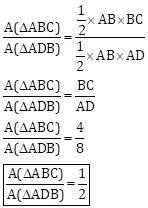
Solution 3
Given:
seg PS ⊥ seg RQ
seg QT ⊥ seg PR
RQ = 6,
PS = 6 and
PR = 12
To find:
QT
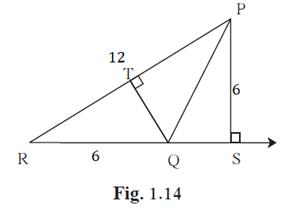
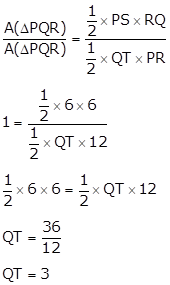
Solution 4
Given:
AP ⊥ BC,
AD || BC
To find:
A(∆ ABC) : A(∆ BCD)
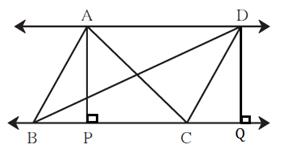
Construction:
Draw DQ
As, AD || BC
AP = DQ
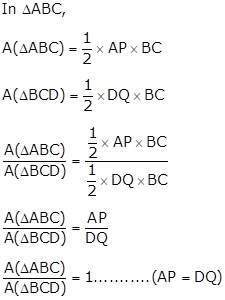
A (ΔABC) : A (ΔBCD) = 1 : 1
Solution 5
Given:
PQ ⊥ BC,
AD ⊥ BC
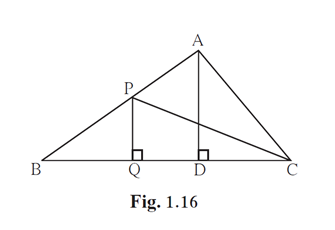
![]()

![]()

![]()

![]()
![]()
Similarity Exercise Ex. 1.2
Solution 1
(1)


Therefore, according to converse of angle bisector theorem PM is the angle bisector of ∠QPR
(2)
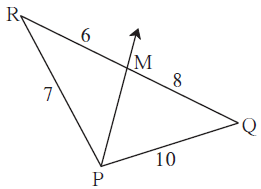

PM is NOT the angle bisector of ∠QPR.
(3)
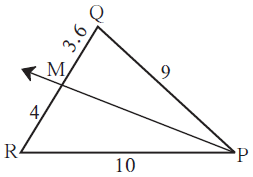

Therefore, according to converse of angle bisector theorem PM is the angle bisector of ∠QPR.
Solution 2
Given:
In ∆ PQR,
PM = 15, PQ = 25
PR = 20, NR = 8
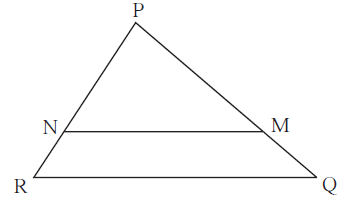
To find:
The line NM is parallel to the side RQ


![]()
According to the proportionality theorem.
∴The line NM is parallel to the side RQ.
Solution 3
Given:
In ∆ MNP, NQ is a bisector of ∠ N
MN = 5,
PN = 7
MQ = 2.5
To find:
QP
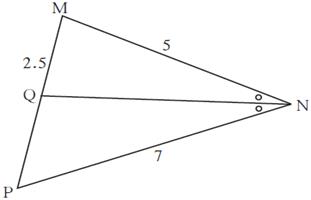
As NQ is a bisector of ∠ N,
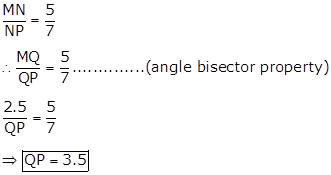
Solution 4
Given:
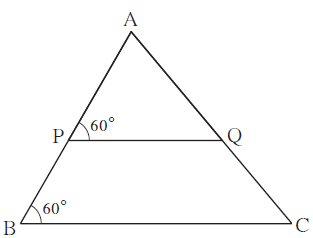
To prove that:
![]()
∠APQ = ∠ABC = 60°
∴ ΔAPQ ≅ ΔABC
PQ ∥ BC……..(corresponding angles are equal)
![]()
Hence proved.
Solution 5
Given:
Trapezium ABCD, side AB || side PQ || side DC,
AP = 15, PD = 12, QC = 14
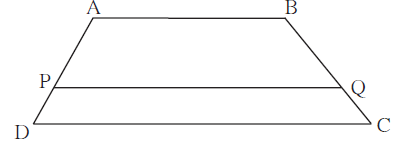
To find:
BQ
As side AB || side PQ || side DC,
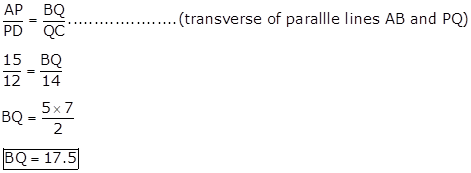
Solution 6
Given:
NQ is angle bisector of ∠MNP
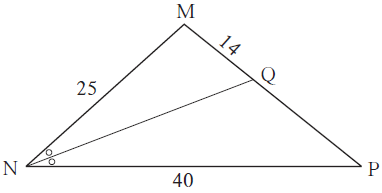
To find:
QP
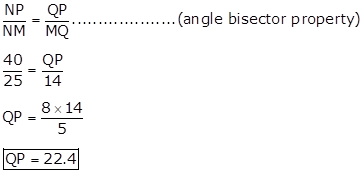
Solution 7
Given:
AB || CD || FE
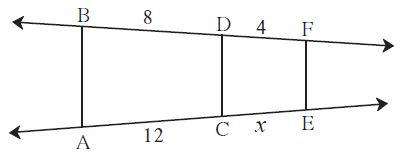
To find:
x and AE
AB || CD || FE
∴ AC, CE, BD andDF are transversals

Solution 8
Given:
In ∆ LMN, ray MT bisects ∠LMN
LM = 6, MN = 10, TN = 8
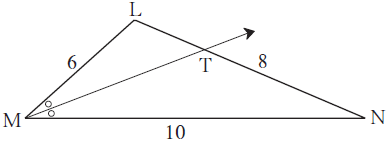
To find:
LT
∠LMN = ∠NMT….(given)

Solution 9
Given:
In ∆ ABC, seg BD bisects ∠ABC
AB = x, BC = x + 5, AD = x - 2, DC = x + 2
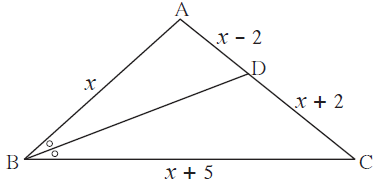
To find:
The value of x
BD bisects ∠ABC

Solution 10
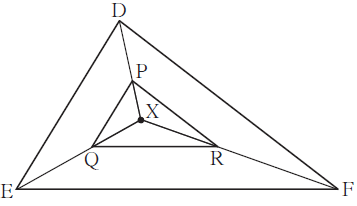
In ∆ XDE, PQ || DE .......... ![]()

∴ seg PR || seg DE......... (converse of basic proportionality theorem)
Solution 11
Given:
In ∆ ABC,
ray BD bisects ∠ ABC
ray CE bisects ∠ ACB
seg AB ≅ seg AC

To prove that:
ED || BC
Proof:
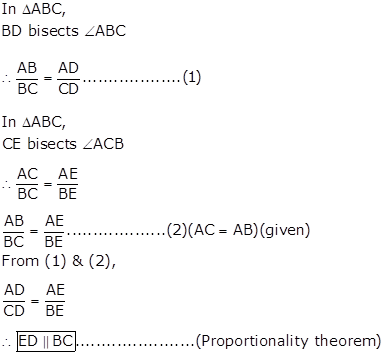
Hence proved.
Similarity Exercise Ex. 1.3
Solution 1
Given:
∠ABC = 75°
∠EDC = 75°

In ΔABC and ΔEDC,
∠ABC = ∠EDC = 75°…….(Given)
∠ACB=∠DEC……(common angle)
∴ By AA Test of similarity we can say,
ΔABC - ΔEDC
One to one correspondence is
ABC ↔ EDC
Solution 2
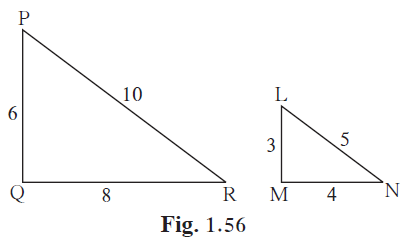

Solution 3
Given:
Heights of two poles, 8m and 4m i.e., AC = 8m, PR = 4m

Poles are perpendicular to the ground i.e., ∠PRQ = 90°, ∠ACB = 90°
The length of shadow of smaller pole due to sunlight is 6 m
Δ PRQ - ΔACB………(As, poles and their shadows creates similar triangle)

The height of the shadow of the bigger pole is 12m.
Solution 4
Given:
In ∆ ABC,
AP ⊥ BC,
BQ ⊥ AC
B- P-C,
A-Q - C
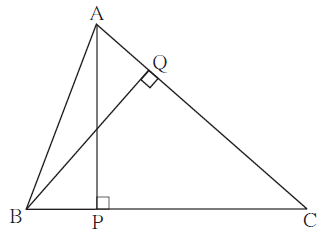
To prove that:
∆ CPA ~ ∆ CQB
In ΔCPA and ΔBQC,
∠CPA = ∠BQC = 90°……..(Given AP ⊥ BC, BQ ⊥ AC)
∠ACB = ∠BCQ……….(common angle)
∴ By AA Test of similarity we can say,
ΔCPA - ΔBQC
Hence proved.
Also given,
AP = 7, BQ=8, BC=12
To find;
AC
As, ΔCPA ∼ ΔBQC

Solution 5
Given:
In trapezium PQRS,
side PQ || side SR,
AR = 5AP,
AS = 5AQ
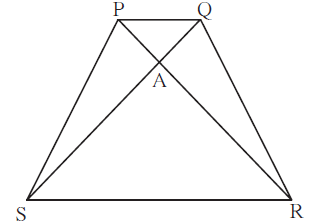
To prove that:
SR = 5PQ
In ΔAPQ and ΔARS,
∠APQ = ∠ARS…….(PQ ∥ SR, alternate angles)
∠AQP = ∠ASR…….(PQ ∥ SR, alternate angles)
∴ By AA Test of similarity we can say,
ΔAPQ - ΔARS

Hence proved.
Solution 6
Given:
side AB || side DC
Diagonals AC and BD intersect in point O
AB = 20
DC = 6
OB = 15
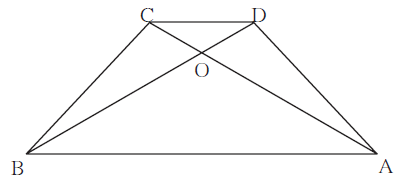
To find:
OD
In ΔABO and ΔCDO,
∠OAB = ∠OCD…….(AB ∥ CD, alternate angles)
∠ODC = ∠OBA…….(AB ∥ CD, alternate angles)
∴ By AA Test of similarity we can say,
ΔABO - ΔCDO
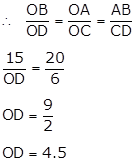
Solution 7
Given:
□ ABCD is a parallelogram
Line DE intersects ray AB in point T
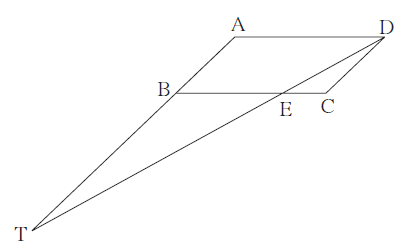
To prove that:
DE ⨯ BE = CE ⨯ TE
Proof:
In ΔBTE and ΔEDC
∠BET = ∠CED…….(Vertically opposite angles)
∠BTE = ∠EDC…….(A - B - T and AB ∥ DC, alternate angles)
∴ By AA Test of similarity we can say,
ΔBTE - ΔEDC

Hence proved.
Solution 8
Given:
seg AC and seg BD intersect each other in point P
![]()

To prove that:
∆ ABP ~ ∆ CDP
Proof:
In ΔABP and ΔCDP,
∠BAC = ∠ADC…….(Vertically opposite angles)
![]()
∴ By SAS Test of similarity we can say,
ΔABP - ΔCDP
Hence proved.
Solution 9
Given:
In ΔABC, point D on side BC is such that, ∠ BAC = ∠ ADC
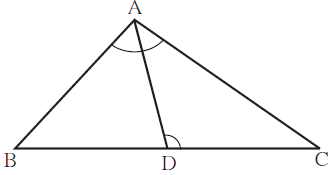
To prove that:
CA2 = CB ⨯ CD
Proof:
In ΔABC and ΔADC
∠BAC = ∠ADC…….(Given)
∠ACB = ∠ACD…….(Common angle)
∴ By AA Test of similarity we can say,
ΔABC - ΔADC

Hence proved.
Similarity Exercise Ex. 1.4
Solution 1
Given:
The ratio of corresponding sides of similar triangles is 3 : 5
We have to find the ratio of their area
Ratio of areas of similar triangle are square of their sides
Therefore,
![]()
The ratio of their area is ![]() .
.
Solution 2
Given:
∆ABC ~ ∆PQR
AB: PQ = 2:3

Solution 3
Given:
∆ ABC ~ ∆ PQR
A (∆ ABC) = 80,
A (∆ PQR) = 125

Solution 4
Given:
∆ LMN ~ ∆ PQR
9⨯A(∆PQR )=16⨯A(∆LMN)
QR=20
To find:
MN
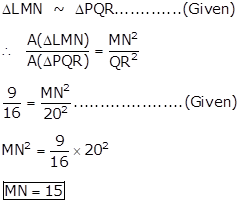
Solution 5
Given:
Areas of two similar triangles
225sq. cm and 81 sq.cm
Side of smaller triangle is 12cm
To find:
The corresponding side of the bigger triangle
AS it is given they are similar triangles,
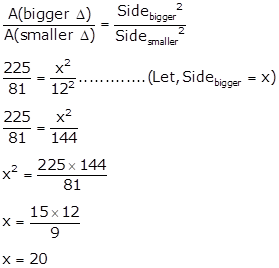
Therefore, the corresponding side of the bigger triangle is 20cm.
Solution 6
Given:
∆ABC and ∆DEF are equilateral triangles
A(∆ABC):A(∆DEF) = 1:2
AB = 4
To find:
DE
Given that ∆ABC and ∆DEF are equilateral triangles
∴ ΔABC - ΔDEF
Therefore,

Solution 7
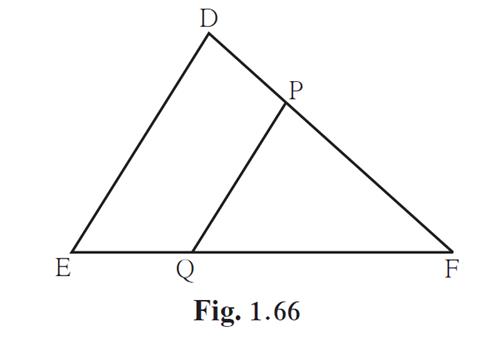
A(∆ PQF) = 20 units, PF = 2 DP,
Let us assume DP = x.
∴ PF = 2x
DF = DP + ![]()
In ∆FDE and ∆FPQ,
∠ FDE ≅ ∠ FPQ .......... corresponding angles
∠ FED ≅ ∠ FQP .......... corresponding angles
∴ ∆ FDE ~ ∆ FPQ .......... AA test
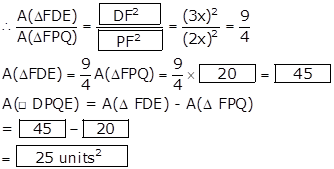
Similarity Exercise Problem Set 1
Solution 1(1)
Given:
![]()
Then in one-to-one correspondence,
∆ PQR ~ ∆ CAB
Answer: (B) ∆ PQR ~ ∆ CAB
Solution 1(2)
Given:
∠ D ≅ ∠ Q,
∠ R ≅ ∠ E
Therefore,
ΔDEF ∼ ΔQRP
![]()
The false statement
is ![]()
Answer: (B) ![]()
Solution 1(3)
Given:
∠ B = ∠ E,
∠ F = ∠C and
AB = 3DE
In ΔABC and ΔDEF
∠B = ∠E
∠C = ∠F
ΔABC - ΔDEF……..(By AA similarity test)
AB = 3DE
Therefore, the triangles are not congruent.
The statement that is true is "The triangles are similar but not congruent."
Answer: (B) The triangles are similar but not congruent.
Solution 1(4)
Given:
∆ ABC and ∆ DEF are equilateral triangles
A(∆ABC):A(∆DEF)=1:2
AB=4
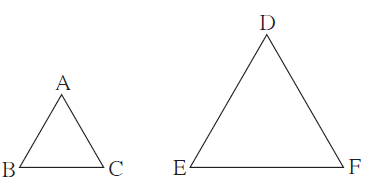
To find:
DE
As, ∆ ABC and ∆ DEF are equilateral triangles
ΔABC - ΔDEF
As we know, the ratio of areas of similar triangles is equal to the corresponding ratio of the squares of their sides
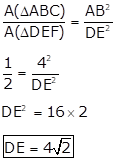
Answer: (D) 4√2
Solution 1(5)
Given:
seg XY || seg BC
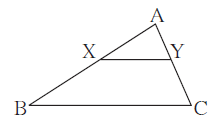
In ΔABC and ΔAXY
∠AXY = ∠ABC……(Corresponding angles of parallel lines AB and XY)
∠AYX = ∠ACB……(Corresponding angles of parallel lines AB and XY)
∴ ΔABC - ΔAXY
Thus,
![]()
Answer: (A)![]()
Solution 2
Given:
B - D - C
BD = 7
BC = 20
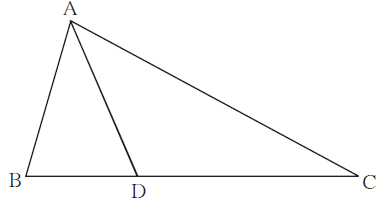
(1) ![]()
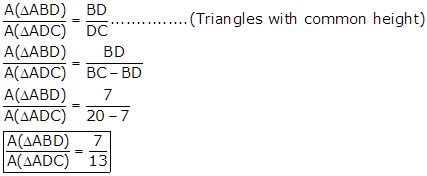
(2) ![]()

(3) ![]()
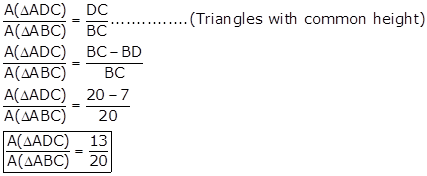
Solution 3
Given;
Ratio of areas of two triangles with equal heights = 2:3
The base of the smaller triangle is 6cm
To find:
The corresponding base of the bigger triangle
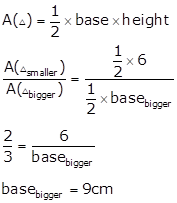
The corresponding base of the bigger triangle is 9cm.
Solution 4
Given:
∠ABC = ∠DCB = 90°
AB = 6,
DC = 8
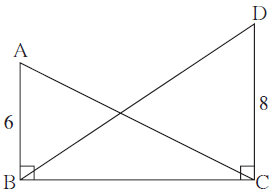
To find:
![]()
In ΔABC and ΔDBC,
∠ABC = ∠DCB = 90°……(Given)

Solution 5
Given:
PM = 10 cm
A(∆PQS) = 100 sq.cm
A(∆QRS) = 110 sq.cm
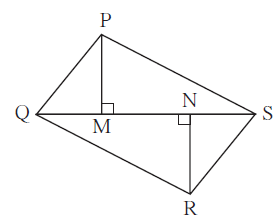
To find:
NR
In Δ PQS,
PM ⊥ QS…….(Given)
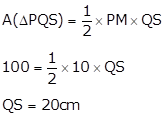
In Δ QRS,
NR ⊥ QS…….(Given)
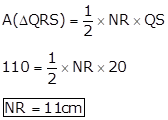
Solution 6
Given:
∆MNT~∆QRS
Length of altitude drawn from point T is 5
Length of altitude drawn from point S is 9
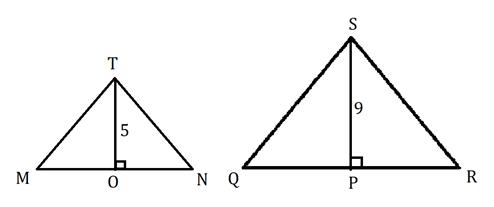
To find:
![]()
In ΔMTO and ΔQSP,
∠TMO = ∠SQP…….(ΔMNT ∼ ΔQRS)
∠TMO = ∠SQP = 90°…….(Given)
ΔMTO - ΔQSP…….(By AA Test of similarity)
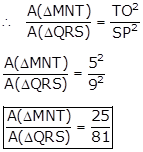
Solution 7
Given:
A - D - C
B - E - C
seg DE || side AB
AD = 5
DC = 3
BC = 6.4
Let, BE=x
To find:
BE
In ΔABC and ΔDEC,
∠CAB = ∠CDE…….(Corresponding angles)
∠CBA = ∠CED…….(Corresponding angles)
ΔABC - ΔDEC…….(By AA Test of similarity)
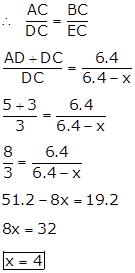
The side BE is equal to 4 units.
Solution 8
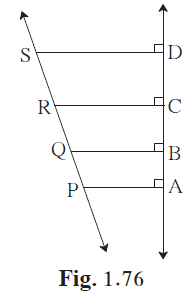
Given:
seg PA, seg QB, seg RC and seg SD are perpendicular to line AD
AB = 60
BC = 70
CD = 80
PS = 280
To find:
PQ, QR and RS
As, seg PA, seg QB, seg RC and seg SD are perpendicular to line AD
PA ∥ QB ∥ RC ∥ SD

Solution 9


In ∆ PMR, ray MY is bisector of ∠PMR.
![]()

∴ XY || QR ................ converse of basic proportionality theorem.
Solution 10
Given:
The bisectors of ∠ B and ∠ C of ∆ ABC intersect each other in point X
Line AX intersects side BC in point Y
AB = 5,
AC = 4,
BC = 6
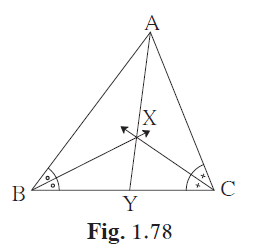
To find:
![]()
In Δ ABY,
BX is the angle bisector……(Given)
![]()
In Δ ACY,
CX is the angle bisector……(Given)
![]()
From (1) and (2),
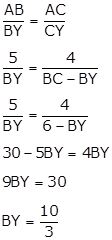
Therefore,

Solution 11
Given:
In □ ABCD, seg AD || seg BC
Diagonal AC and diagonal BD intersect each other in point P
To show that:
![]()
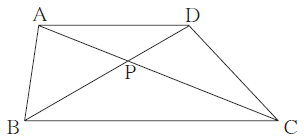
In ΔAPD and ΔCPB
∠DAP = ∠PCB……….(Alternate angles of parallel lines AD and BC)
∠PDA = ∠PBC……….(Alternate angles of parallel lines AD and BC)
ΔAPD - ΔCPB………...(By AA Test of similarity)
Therefore,

Hence proved.
Solution 12
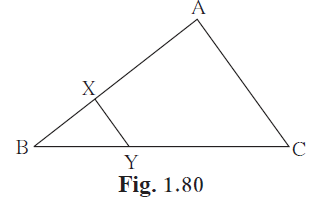
Activity: 2AX = 3BX ![]()
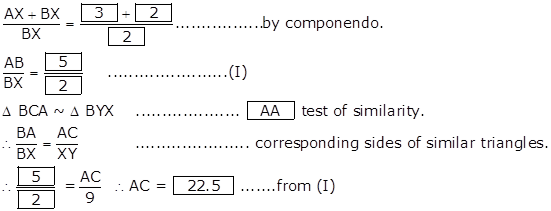
Solution 13
Given:
The vertices of square DEFG are on the sides of ∆ ABC
∠A = 90°
To prove that:
DE2 =BD⨯EC
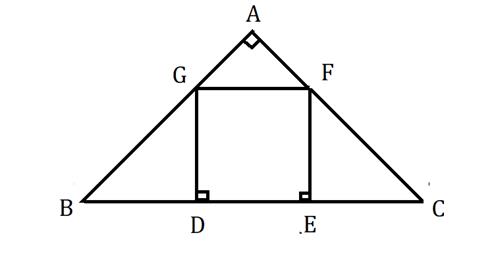
In ΔBAC and ΔBDG,
∠BAC = ∠BDG = 90°
∠ABC = ∠DBG……..(Common angle)
ΔBAC - ΔBGD……(By AA Test of similarity)
In ΔBAC and ΔFEC,
∠BAC = ∠FEC = 90°
∠ACB = ∠ECF……..(Common angle)
ΔBAC - ΔECF……(By AA Test of similarity)
Therefore,
∴ ΔBGD - ΔFEC
Thus,
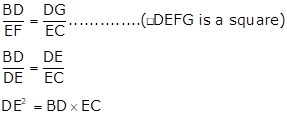
Hence proved.

